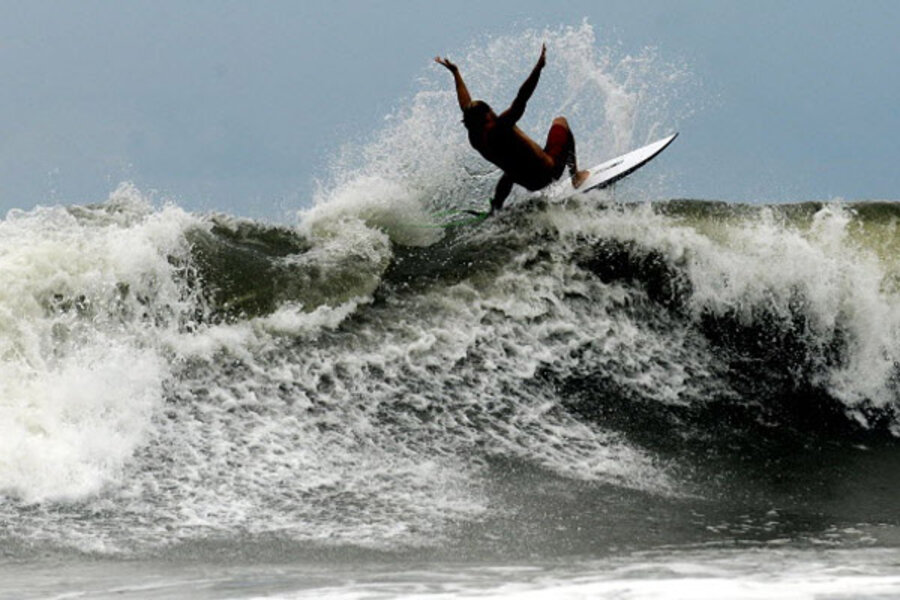Hurricane Irene: why storm surge could be the biggest problem
Loading...
As hurricane Irene begins its trek through the Bahamas on its way to the US East Coast, officials are cautioning coastal residents – particularly in North Carolina – to be prepared to evacuate when local officials put out the call.
The reason: storm surge, one of the most potentially destructive features associated with tropical cyclones.
In preparing for Irene's arrival, "the most important thing we need to remind people is that the principal threat that evacuations are ordered for is storm surge," says Craig Fugate, who heads the Federal Emergency Management Agency.
Indeed, evacuations already have begun in sections of North Carolina's Outer Banks, a popular summertime vacation area with limited routes to and from the Banks' barrier islands.
As of 2 p.m. EDT Wednesday, forecasters at the National Hurricane Center in Miami said they expected tropical-storm-force winds from Irene's expansive mass of clouds to reach the Outer Banks Saturday morning.
"Often, evacuation orders are given when the skies are blue and the weather's fair," Mr. Fugate says. But he cautions people not to use good weather at the moment as a reason to wait until the next forecast cycle to make their move.
The time between the first evacuation orders and a storm's arrival can range from several hours to 24 hours or more in advance, depending on the storm's size, speed, the number of people who need to be moved, and the capacity of evacuation routes to handle heavy traffic.
Tropical cyclones generate surges by pushing a bulge of wind-driven water ahead of them as they move along.
Perhaps 5 percent of a surge's height can be traced to an extra bulge at the sea surface, imparted by very low atmospheric pressures inside a hurricane's eye. But the vast majority of water bulldozed by a storm results from the counterclockwise circulation of winds dragging surface water along with them, explains Jamie Rhome, who leads the storm-surge unit at the National Hurricane Center.
That circulation tends to put the highest part of the surge in the upper-right-hand quadrant of a storm as its track is viewed from above.
Yet a temporary rise in sea level that a surge brings represents only part of the surge-hazard story. A hurricane's winds whip up enormous waves that ride atop the surge. Without those waves, storm surges would behave more like a steadily cresting and receding river flood. But the waves act as relentlessly pounding aquatic sledgehammers.
This repetitive assault by tons of water for hours on end collapses the stilt-perched beach homes and other structures that otherwise might have remained intact had they been built on a river flood plain, with just a high flood crest to endure.
Barrier islands and coastal wetlands can blunt the impact of surges and their waves. But heavy coastal development along the country's Gulf and East Coasts have often compromised those natural barriers. Louisiana's sinking delta and the loss of its wetlands are perhaps the most striking example, many coastal-restoration specialists say.
As a tropical cyclone approaches landfall, the final height of the surge is determined by the storm's speed, strength, the depth and extent of the continental shelf that the storm passes over, as well as local features – bays, estuaries, coastal marshes – that the surge encounters.
One extreme example came in September 1938, when a storm variously called the Great New England Hurricane or the Long Island Express drove north into central New England. Scientists have determined that the storm qualified as a Category 3 by today's rating system – a major hurricane.
Rhode Island's narrow, north-south-running Narragansett Bay, with the capital Providence at the northern end, sat in the path of the storm's upper-right quadrant. Tides, already high because of a full moon, surged to 16 feet above normal and swept up the bay, submerging parts of Providence under 13 feet of water.
In the early 1960s, Providence built a surge barrier across the mouth of the Providence River to protect the city center from future storm surges.
Trying to combine all the interactions between storm, ocean, and coastline make storm-surge projections a difficult challenge, Mr. Rhome says. They can combine in ways that can produce some "counterintuitive flooding."
Hurricane Irene, for instance, is projected to pass over or just east of Cape Hatteras. But some of the worst surging is projected for the cape's Pamlico Sound, which is projected to be the left side of the track, far from the quadrant most often associated with the worst storm-surge damage.
The cape juts like a broad arrowhead into the Atlantic. As Irene passes the cape, the storm will have some open water to its west, instead of land. As the storm's broad, counterclockwise circulation swings out of the north along that west side, the circulation is projected to drive seawater over a relatively shallow seafloor and back into Pamlico Sound.
[ Video is no longer available. ]


